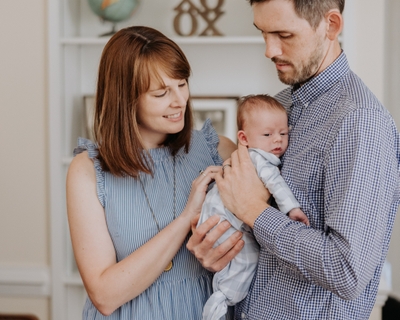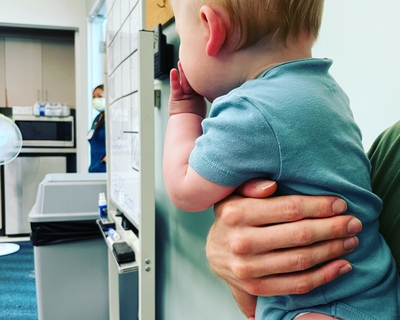Becky DeCamillis, an infectious disease physician assistant, explains her reasoning and research. She is a physician assistant with Novant Health Infectious Disease Specialists in Winston-Salem. Another version of this article first appeared in The Charlotte Observer and other North Carolina newspapers.
To find and book a pediatrician click here.
By Becky DeCamillis, Novant Health Healthy Headlines
Everyone has a pandemic story. Mine is no worse than anyone else’s, but it may be a little different.
On March 16, 2020, with New Zealand just hours away from closing its borders, my husband, Mason and I boarded a plane home to the United States: We had made our choice about where to ride out the pandemic. In hindsight, of course, sometimes I wish we had stayed, particularly, given the success of New Zealand’s “zero COVID” approach that bridged them to the vaccine’s release. However, as a physician assistant working in infectious diseases, staying abroad wasn’t an option for me. A pandemic is THE big game, our call to the majors, our 15 minutes.
At home, those early days of the pandemic were especially difficult because we didn’t know what to expect, how deadly this infection was (or wasn’t), or how long things would last. Tom Hanks seemed to be faring OK, but he was still in a hospital in Australia. We’d probably have a tough few months ahead, I thought, but things would get back to normal by the summer, fall at the latest. My husband and I, relatively young and healthy, figured we’d be OK if we got sick, although there’s always some question of “what if?” But truly, as we looked to start a family soon, the worst case scenario that I could think up was that I’d get COVID-19 while pregnant and have, as we say in medicine, “a bad outcome.”
 As the COVID era dragged on, we all hunkered down, wore masks, picked up groceries curbside and watched “Tiger King.” In the hospital, we saw patients admitted with COVID who thought they were through the worst of it – fevers subsided, headache improved – when all of a sudden, they couldn’t breathe. In medicine, we’re used to looking to the literature to guide our clinical practices, but we didn’t have much to go on. Watching patients die without any proven therapeutics was agonizing. Entering rooms of COVID patients in gowns, gloves, two masks and a face shield was dehumanizing to both the patients and caregivers.
As the COVID era dragged on, we all hunkered down, wore masks, picked up groceries curbside and watched “Tiger King.” In the hospital, we saw patients admitted with COVID who thought they were through the worst of it – fevers subsided, headache improved – when all of a sudden, they couldn’t breathe. In medicine, we’re used to looking to the literature to guide our clinical practices, but we didn’t have much to go on. Watching patients die without any proven therapeutics was agonizing. Entering rooms of COVID patients in gowns, gloves, two masks and a face shield was dehumanizing to both the patients and caregivers.
On Sept. 18, 2020, I awoke with a fever and stabbing headache. I had COVID. I was also newly pregnant. Other than going to work at the hospital, where I was doing all I could to stay safe, I rarely left the house. How could this have happened?
Immediately after the thermometer read out 101.7, I moved to the other side of the house, where I spent the next 10 days in isolation. I also miscarried our first baby.
Those 10 days were extraordinarily difficult, not knowing if I’d infected my husband, not being able to mourn our baby together, and enduring the loneliness of physical isolation and miscarriage all at once. The grief of the loss was compounded by the fear of suffering some complication that I’d seen firsthand in patients: Young people with no chronic medical problems suffering strokes or bleeding problems, for example. Thankfully, I recovered physically and my husband stayed healthy. I’ll never know whether COVID played a role in my miscarriage or if it would’ve happened anyway, but I’ll also never be able to disentangle the two.
In December 2020, I got my first vaccine as soon as it became available, about 90 days after my COVID infection. There were lots of tears and sniffles through the masks from other health care providers like me. Surely this was the beginning of the end.
Around the time I was due for my second shot in January, I started feeling some nausea. I knew in my bones I was pregnant again but decided not to take a pregnancy test.
Why? It was too hard to confront the fact that I had to make a choice about whether to get a vaccine that had not been tested in pregnant women yet.
I know there are people out there who think doctors and other providers like me just blindly embraced COVID vaccines without regard for the safety of others. Nothing could be further from the truth. Potentially, the safety of my unborn child was on the line.
Having to make that decision as an expectant mother was about as personal as it gets. Because I was deeply steeped in the science behind mRNA vaccines as part of my job, I felt these vaccines were safe — in fact, safer than NOT getting vaccinated. I got the second dose.
Nine months later, on Sept. 18, 2021, exactly one year after my worst day, came the best day. Our sweet baby boy, Jacob, was born, happy and healthy. I knew from the time I saw those two pink lines on the pregnancy test that he’d arrive right on cue.
My family weathered the delta surge like we had other waves – at home. Only this time, we had a much more fragile life to protect. But all the experts seemed to think maybe this was the last surge before the long-awaited “endemicity,” so by the time I went back to work from maternity leave, COVID would surely all be in the past.
In November 2021, I got my booster. If I couldn’t protect Jacob yet with a shot of his own, maybe I could give him some antibodies passively. And, I knew we could surround him with a circle of fully vaccinated adults.
I returned to work in January 2022 on the upswing of the omicron wave, fighting feelings of guilt, exhaustion and anxiety. There were reports that omicron was affecting small kids more severely than previous strains. Again, we didn’t have much data: Another chapter of the pandemic, unfolding in real time. I wore an N95 all day, only taking two breaks to eat and drink, which was no pleasure as a nursing mother.
 When will our little ones be vaccine-eligible? “Spring,” they said. Spring came and went, and the evidence wasn’t strong enough to recommend it, so the Food and Drug Administration asked for another round of data. Ultimately, of course, I’m grateful for the painstakingly thorough review process that happens in the FDA and Centers for Disease Control and Prevention, but in the moment, for parents like me, this was a really, really tough pill to swallow.
When will our little ones be vaccine-eligible? “Spring,” they said. Spring came and went, and the evidence wasn’t strong enough to recommend it, so the Food and Drug Administration asked for another round of data. Ultimately, of course, I’m grateful for the painstakingly thorough review process that happens in the FDA and Centers for Disease Control and Prevention, but in the moment, for parents like me, this was a really, really tough pill to swallow.
It felt like the rest of the world had moved on: Mask mandates had been lifted and much of society had returned to pre-pandemic life, but many parents with small kids were still living like we were in 2020. I’m still thinking about the “Hamilton” tickets we gave up during one of the surges. But my husband is a statistician and I specialize in infectious diseases. When it comes to taking chances, we’re not exactly Bonnie and Clyde.
On June 18, 2022, the Advisory Committee on Immunization Practices (ACIP), a part of the CDC, voted unanimously to approve COVID vaccines for kids under 5. We were driving and I was listening to the vote in the car. I sobbed tears of joy.
Four days later, on June 22, my 9-month-old son, Jacob, received his first dose of the COVID vaccine.
Although cases are up again, I can feel this chapter of life closing for my family, and a new chapter beginning. When Jacob is fully vaccinated in a few weeks, we’ll invite some long-awaited normalcy back into our routine, and introduce Jacob to all kinds of new experiences. Some may wonder, “What’s the big deal? Kids usually have an easy time with COVID.” While that’s true, it’s certainly not a guarantee. We vaccinate for other diseases with much lower rates of hospitalization than COVID, like hepatitis A and chickenpox.
Since the start of the pandemic, COVID has claimed the lives of over 400 children aged 0-4 and has hospitalized many more. Additionally, we’ve seen significant morbidity among kids from complications like MIS-C and long COVID.
The best way to mitigate those risks is to get vaccinated to establish baseline immunity to the virus. Personally, I was waiting to review the vaccine safety data myself to ensure that these shots will be safe for the youngest kids, and after poring over tables and figures detailing efficacy and side effects, I was eager to be one of the first in line to get my child vaccinated.
It’s important to point out that as new variants have emerged, vaccination may not prevent every case of COVID, especially now in the age of BA.5.
We all know adults who’ve been vaccinated and still contracted it. But we have to remember that the goal of any vaccination program is not to prevent every illness. The real value of these vaccines is in their ability to prevent serious illness, hospitalization and death. So, for parents like me, getting our children vaccinated can give us the peace of mind that if our kids contract COVID, it will likely be little more than a runny nose.
I’m ready for Jacob to experience the world; I just want him to have all the protection he deserves.
Novant Health
Healthy Headlines
Facebook
Instagram
Twitter
YouTube




